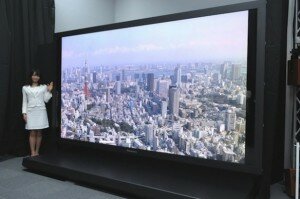What is Super Hi-Vision?
Super Hi-Vision is a digital video format created by Japan’s state broadcaster NHK that is positioned as ‘the future of television’ due to its ultra-high resolution picture quality and immersive 3D sound.
Super hi-Vision (sometimes referred to as UHDTV) packs in 7680 x 4320 pixels, twice that of 4K and sixteen times more detail of HD (1920 x 1080). Super Hi-Vision camera sensors are 33.2 megapixels and a viewing angle of 100 degress is supported.
Audio is also highly upgraded. The sound format is 22.2 multi-channel surround sound with speakers at three different heights. NHK are currently working towards reducing the required amount of speakers (22 plus two sub woofers) to about five, making it more viable for the home environment.
As you can imagine, the data volumes can be mammoth. The raw uncompressed data rate – 40Gbit/s (at 60fps), the speed that digital data comes out of camera which is compressed. Compression rates are being improved all the time. The recent public viewings for the London Olympics were compressed to 350 Mbps and the ultimate goal is to improve compression further by using the new High Efficiency Video Codec which should allow for a 100 Mbps data rate by the time experimental broadcasting begins.
NHK plan to skip the transition to 4K and Keiichi Kubota, NHK’s Executive Director-General for Engineering have spoken about bringing the goal of domestic Super Hi-Vision broadcasting in 2020 forward a few years, thanks to the technology progressing faster than expected.
The current frame rate is 60 frames per second. However, by the time experimental broadcasts happen, it is expected that the frame rate will be increased to 120 frames per second as moving images can appear blurring at this resolution on large scale screens.
Super Hi-Vision is believed to be the final definition upgrade in a long time. However, SHV could also transform 3D television through a technology known as Integral 3D which does not require glasses and allows the viewer to look around objects.
How Super Hi-Vision can be watched
There are only a handful of Super Hi-Vision displays in the world and they are very expensive. Sharp have created an 85” LCD 8K display and Panasonic’s 145” model has impressed audiences in Tokyo.
NHK has also developed a high frame rate SHV projector as a display device with JVC KENWOOD Corporation. The projector employs three 8 million pixel display devices and an e-shift device. The speeds of the e-shift device and display devices have achieved SHV picture display operating at 120 Hz.
Super Hi-Vision cameras
Cameras have fallen from 80Kg in 2002 to 20Kg in 2010. A new prototype weighs just 4Kg, has a 33 megapixel camera head and uses a single-plate colour imaging mechanism. This fourth generation camera will be used for trials in 2014. Ikegami Super Hi-Vision cameras have been used for the London Olympics Super Hi-Vision trial. The first generation of Super Hi-Vision cameras did not allow for zooming but the new generation of cameras do offer support for zooming and can be fitted with regular commercial lenses from Fujinon and Canon.
Super Hi-Vision Transmission
Due to the format’s bandwidth hungry data requirements, transmitting Super Hi-Vision audio uses a highly efficient codec system. NHK have trailed experimental broadcasts over satellite and even terrestrial infrastructures. The global IP network is expected to be the platform of choice however. The London Olympics Super Hi-Vision trials use the JANET network to enable the first ever super hi-vision feed transmission to multiple global locations (Bradford, London, Liverpool, Tokyo, Fukushima and Washington DC).
Applications for Super Hi-Vision
NHK expect Super Hi-Vision to be utilised by non-broadcast industries first. Doctors are already using the format to shoot operations in 8K resolution. Digital signage is likely to make use of the format and a telecommunications company is planning to trial it for 8K video conferencing. One could also expect the military to find uses for it as well as themeparks.
Super Hi-Vision Content
Like 3D, it will take a while before there will be enough content to fill the airwaves with crystal clear images. NHK are building up a library of content but it might be a while before cameras are available and low cost enough to give producers the opportunity to film some content.
Super Hi-Vision Timeline
2000 Research starts on a system with 4000 scanning lines
2002 First public presentation at a ceremony commemorating the opening of the new building for NHK’s Science and Technical Research Laboratories (camera, display, audio equipment, recording equipment invented). They used they used an array of 16 HDTV recorders to capture the 30-minute-long test footage.
2004: NHK names the system Super Hi-Vision
2005 Mar/Sept: Presented at the Aichi World Exposition
Oct: Exhibited at Kyushu National Museum
Nov: Successful transmission of uncompressed data via optical cable
Dec: Live transmission for the public viewing of Red & White Year-end Song Festival (at NHK Fureai Hall)
2006 April: Debut outside Japan (NAB 2006 Las Vegas)
July: Approved by ITU-R for large screen digital imagery
Sept: Exhibited at IBC Amsterdam
Dec: Live IP relay from Tokyo to Osaka for public viewing.
2007 April: NAB 2007
Oct: Image format becomes SMPTE standard
2008 April: NAB 2008
Jun: Debut in Asia (Broadcast Asia 2008 Singapore)
Aug: 22.2 multi-channel sound adopted as SMPTE standard.
Sep: First international transmission by cable and satellite (IBC 2008)
2010 Sept: NHK partnered up and recorded The Charlatans live in the UK in the UHDTV format, before broadcasting over the internet to Japan.
2011 May: SHARP in collaboration with NHK demonstrated a direct-view 85" LCD display capable of 7680 x 4320 pixels at 10 bpp
2012 Feb: NHK announced that with Shizuoka University, they had developed an 8K sensor that can shoot video at 120 frames per second.
April: NHK (in collaboration with Panasonic) announced a 145-inch display (7680 x 4320 at 60 fps), which has 33.2 million 0.417 mm square pixels.
May: NHK showed the world's first Ultra High Definition shoulder-mount camera.





